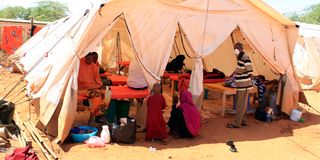We can put an end to cholera outbreaks. Here’s how

Wards at the Cholera Treatment centre at Mandera Referral Hospital.
What you need to know:
- According to the Ministry of Health, the country has recorded about 5,000 cases of cholera and 85 deaths since the outbreak.
- The World Health Organization report says Kenya is among the top five countries in Africa with the highest number of infections. The country’s case fatality ratio is 1.8 per cent.
A junior doctor called me for consultation a few weeks ago. He had just seen a patient who had presented with profuse diarrhoea for a week. The patient looked slightly dehydrated but could still feed and drink water. The doctor wondered whether we could test and start treatment for typhoid and amoeba infections. It didn’t occur to him at that time that we could be dealing with a cholera infection at the heart of Nairobi. Such is the impetus to this discussion.
Cholera outbreaks are known to occur specifically in the developing world where sanitation and water filtration standards may be substantively deficient. Currently, cholera is known to be endemic in approximately 50 nations, mostly throughout Africa and Asia. The incidence is tied to a seasonal distribution, depending on the timing of the region’s rainy season.
In Kenya, the current outbreak was first reported in Limuru, Kiambu County on October 8, last year and has so far spread in 15 counties among them Nairobi, Nakuru, Kajiado, Uasin Gishu, Muranga, Machakos and Garissa.
According to the Ministry of Health, the country has recorded about 5,000 cases of cholera and 85 deaths since the outbreak. The World Health Organization report says Kenya is among the top five countries in Africa with the highest number of infections. The country’s case fatality ratio is 1.8 per cent.
The high population density in these counties propels the spread of the outbreak to other counties. Poor and unreliable water supplies and worsening socioeconomic conditions further precipitate the situation. Food insecurity, especially with the current state of the economy, exacerbates the vulnerability of low and middle-income communities to the spread of cholera. A balanced diet is a luxury to some, and poor nutrition weakens the immune system; increasing a person’s risk of severe symptoms and death.
So, where should we begin? Coordination of the cholera response by strengthening the primary health care units for the management of such health emergencies should be the first step. Health workers must maintain a high index of suspicion. The diagnosis of cholera can be based on clinical presentation.
The characteristic high-volume diarrhoea in an endemic area can be sufficient for a diagnosis. Treatment requires aggressive rehydration. Oral rehydration therapy is a simple, cost-effective weapon to fight dehydration, which is the main cause of death from cholera. Education on early detection and treatment under the umbrella of a strong primary health care system is the best preparation for a cholera epidemic.
Community sensitisation is needed. We must be cognizant of the reality that cholera outbreak is with us. Head knowledge must be followed with practical application. Operationalising the knowledge into practices like hand hygiene and proper faecal waste disposal is key in preventing the spread of the disease.
Water should be boiled before drinking. Since contamination via food is common, all food and fruits should be washed with clean water. Citizens should be advised to use the mantra: Boil it, Cook it, Peel it, or Forget it! Modifying human behaviour is not easy but can be done through community outreach programmes. Personal hygiene and responsibility should be emphasised as an intervention in controlling the spread of cholera.
In addition, control strategies such as vaccination should be adopted. The oral cholera vaccines have been administered to millions of recipients and are safe and effective. In Kenya, the vaccine is administered in two doses and provides 60–85 per cent protective efficacy for two-three years.
Kenya has not had a concerted mass vaccination campaign. Vaccination during cholera outbreaks helps to contain ongoing outbreaks and to limit the spread into new areas. Endemic areas as well as the most vulnerable populations must be targeted in the initial drive of the cholera vaccine.
Improving access to water, sanitation and hygiene is a critical step in reducing not only Kenya’s but Africa’s cholera burden. Our leaders should ensure access to safe water and invest in proper sanitation infrastructure. Ultimately, the cholera outbreak must be given a front seat in our conversations for us to eradicate it once and for all.
Dr Gathu is a clinical assistant Professor, Department of Family Medicine, Aga Khan University Medical College, East Africa




